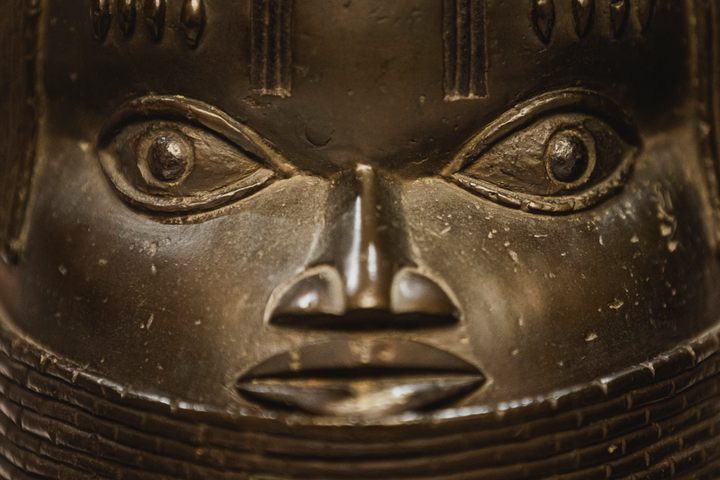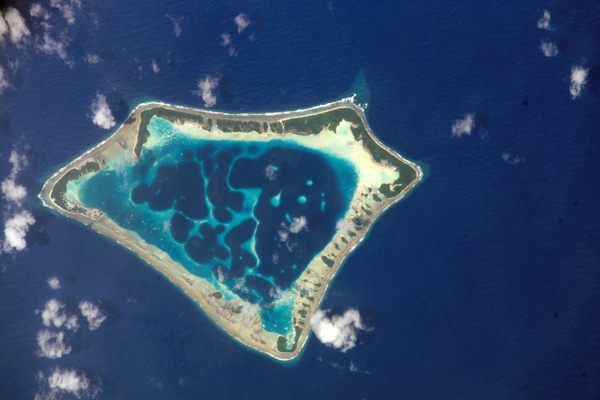
Are the Benin Bronzes Made From German Brass—And Does It Matter?
The famous West African artworks, long at the center of repatriation debates, were made from materials sourced in Rhineland.
On a humid February day in 1897, with smoke from relentless shelling hanging heavy in the royal city, the invading force advanced. More than a thousand British soldiers, bolstered by auxiliary troops, attacked the centuries-old seat of the forest kingdom, among the most powerful in West Africa. England would claim the military operation was retaliation for the killings of a few of its citizens after they violated the kingdom’s sovereignty. But in truth, it was a ruthless assault to vanquish the Kingdom of Benin and gain control of its wealth. By the time it was over, Benin City was in ashes.
Amid the untold civilian casualties, destruction of homes, and other brutalities, the invaders looted thousands of royally-commissioned figures, masks, plaques, and other objects, some carved from wood or ivory but most cast in brass or bronze. Collectively known today as the Benin Bronzes, these treasures were hauled to the coast, loaded onto ships, and, eventually, made their way to some of the most famous museums and private collections in Europe and the United States.
There, for more than a century, the Benin Bronzes were displayed, often without mention of their significance as religious or commemorative objects. More recently, as the importance of the Benin Bronzes as cultural heritage has been more broadly acknowledged, the magnificently detailed faces and intricate scenes of royal life have been at the center of often-heated political, cultural, and legal debates over repatriation and reparation for their violent theft.

Now, there’s a new wrinkle in the story. Published today in the journal PLoS One, a novel geochemical analysis suggests that the raw material used in the production of Benin’s famous metalworks came from Rhineland, in western Germany. The findings are a scientific first, but the bigger question is: Does it matter where the metal came from?
“I don’t think this is of enormous interest to the Edo people themselves. Where the material originally came from is a bit neither here nor there,” says Barnaby Phillips, journalist and author of Loot: Britain and the Benin Bronzes. (The term “Edo” can refer to both the historic kingdom of Benin, also known as the Benin Empire or Edo Empire, and the modern Nigerian state, located at what was the heart of the ancient kingdom; some experts prefer to use the term Edo to distinguish the kingdom and its people from the modern country of Benin, to the west of Nigeria.)
Perhaps the most interesting thing about the paper is its method: The team compiled data from previously published analyses of metals used in objects considered Benin Bronzes, and compared those results with new analysis of something perhaps unexpected: artifacts retrieved from shipwrecks.
Specifically, the team analyzed the composition of dozens of objects called manillas, retrieved from five shipwreck sites around the Atlantic and three archaeological sites in West Africa and Europe. Manillas are small, c-shaped pieces of brass that were manufactured in Europe and used by Portuguese traders as currency along much of the West African coast from the late 15th to the 19th century. All of the manillas analyzed in the study came from sites or shipwrecks, from Massachusetts to Sierra Leone, that had ties to Portuguese trade during this era.

After comparing the previously published chemical signatures of the Benin objects with those of the manillas and an established database of European ores, the researchers concluded that “this study definitively identifies the Rhineland as the principal source of manillas.… Millions of these artifacts were sent to West Africa where they likely provided the major, virtually the only, source of brass for West African casters between the 15th and the 18th centuries.” It’s the first time anyone has tied the raw material ultimately used to produce the Benin objects to a specific geographic area—but a European origin for the material is not a surprise to scholars familiar with the Benin Bronzes.
“A significant part of the metal that constitutes Benin bronze came from Europe. It’s only natural to start with the Portuguese connection [when researching its origin],” says Ndubuisi Ezeluomba, curator of African art at the Virginia Museum of Fine Arts in Richmond. Ezeluomba, who has written extensively about the objects from an arts management perspective, says he found the paper “exciting,” but would like to see more details.
Despite the new paper’s emphasis on a German origin for the raw material Benin artists used, brass objects had been produced in West Africa long before European contact. While some regional metalworking traditions lasted for a century or two, the Kingdom of Benin’s casters were at work for at least 500 years, and possibly much longer. “What helped in the Benin case was it was under the control of the king, he was the sole patron at that time,” says Ezeluomba. “These were not objects made for the ordinary person. They were made to beautify the palace and decorate royal shrines. All the plaques you see were just like normal photographs, put on the palace wall to decorate them.”

Despite its longevity—or perhaps because of it—the very roots of Benin’s bronze and brass casting tradition remain a mystery, and a source of contention between people in today’s Edo state and surrounding regions, notably the Yoruba people to the northwest, many of whom have ancestral ties to the ancient Ife Kingdom. The dates of manufacture for many of the items are also uncertain or contested.
“There is a great historic rivalry between the Ife and Benin kingdoms, and there is a great deal of sensitivity as to which came first and which influenced the other,” says Phillips. “[But] the Ife civilization is producing these amazing objects, certainly predating contact with the Europeans.… Of course, Edo historians are adamant that their own metal casting tradition, be it bronze or brass, predates the arrival of the Europeans.”
One thing researchers, historians, and curators alike agree on: “The arrival of the Europeans is a catalyst for expanded production,” says Phillips, adding that the sudden and substantial availability of brass, in the form of manillas, would have given the Benin artists much more material to work with.

The paper’s lead author and designated media contact Tobias Skowronek declined interview requests for this story. Skowronek is a geochemist at the Technische Hochschule Georg Agricola in Bochum, near Dusseldorf and coincidentally close to the area where his team believes the raw material for the Benin Bronzes was mined.
Some feel the new research may be less about a scientific breakthrough and more about researchers wanting to participate in some way in the broader discussion of the objects, currently a popular topic on social media and elsewhere. “The Benin Bronzes have become emblematic of the debate around colonial looted art for a couple of reasons. The first reason is that they are very fabulous, [and] the way in which they were taken was particularly egregious,” says Phillips. “And if you’re more or less anywhere between Seattle and Stockholm, there are Benin Bronzes in your nearest museum. So it has great resonance in different countries and has fitted into the postcolonial discourse.”
It’s unclear what, if any, impact the new paper may have on ongoing political and legal maneuvering around efforts to return the artifacts to Nigeria. While museums in some countries, notably Germany, have already returned dozens of the objects or have committed to do so, some opposition continues. In 2022, the Restitution Study Group (RSG), which describes itself as a nonprofit concerned with slavery justice, launched a legal challenge to the Smithsonian Institution’s transfer of ownership of several objects to the Nigerian government. RSG’s argument is that the Benin Bronzes are culturally significant to descendants of enslaved people in the United States, and should remain accessible to them, because they were cast from melted-down manillas that Europeans traded with Benin nobility “in exchange for abducted and enslaved neighboring non-Beni people.” (“Beni” or “Bini” is another name for the language, also known as Edo, spoken in the kingdom.)
While a judge denied RSG’s attempt to stop the transfer in October, the legal battle points to a question of much greater significance than where the metal in the Portuguese manillas was mined: “To put it crudely, to what extent were these [manillas] being traded for slaves?” says Phillips. The answer, based on historical evidence, appears to be that the Kingdom of Benin had fewer connections to the transatlantic slave trade than other regional kingdoms.
Phillips notes that the forest kingdom, which was inland and not directly accessible to ships involved in the slave trade, had significant natural resources and industries, such as palm oil, ivory, and textiles. “I think Edo historians are on to something when they say their own kingdom was a lot more powerful than many of the other kingdoms that Europeans engaged with, and crucially had other things the Europeans wanted to buy,” he adds.
While the links between the slave trade and the manillas melted down for the casters’ use remain uncertain and controversial, the brutality with which the Benin Bronzes were taken is incontrovertible. Ezeluomba, who grew up in modern Benin City, says he considers the objects as art, and studies them with professional detachment. However, he adds, “The history of how those things were removed, that’s what gets me. The sheer scale of the human casualties that these guys unleashed on Benin, the number of bullets that came out of those machine guns, those are the facts that actually get me.… It was very brutal. I always have that in the back of my mind.”
For advocates of the return of the Benin Bronzes to what is now Nigeria, repatriation is a start, but only the first step in what must be a thoughtful process of remediation. Ezeluomba says it’s not just about returning the stolen goods to Benin City; Western museums, governments, and scholars should assist in infrastructure building, training, and other initiatives that will preserve the items for generations to come.
Considered in this broader context, the question of whether the Benin Bronzes were cast from material mined in western Germany is a footnote. “If a Nigerian artist buys all their paints and canvas from Europe, is it European art?” Ezeluomba asks. “It’s not about the materials, it’s about who made the work.”





















































Follow us on Twitter to get the latest on the world's hidden wonders.
Like us on Facebook to get the latest on the world's hidden wonders.
Follow us on Twitter Like us on Facebook